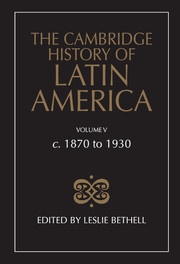Book contents
- Frontmatter
- PART ONE MEXICO
- PART TWO CENTRAL AMERICA AND THE CARIBBEAN
- PART THREE THE RIVER PLATE REPUBLICS
- 9 The growth of the Argentine economy, c. 1870–1914
- 10 Argentina: society and politics, 1880–1916
- 11 Argentina in 1914: the pampas, the interior, Buenos Aires
- 12 Argentina from the first world war to the Revolution of 1930
- 13 The formation of modern Uruguay, c. 1870–1930
- 14 Paraguay from the War of the Triple Alliance to the Chaco War, 1870–1932
- PART FOUR THE ANDEAN REPUBLICSo
- PART FIVE BRAZIL
- Bibliographical essays
- References
10 - Argentina: society and politics, 1880–1916
from PART THREE - THE RIVER PLATE REPUBLICS
Published online by Cambridge University Press: 28 March 2008
- Frontmatter
- PART ONE MEXICO
- PART TWO CENTRAL AMERICA AND THE CARIBBEAN
- PART THREE THE RIVER PLATE REPUBLICS
- 9 The growth of the Argentine economy, c. 1870–1914
- 10 Argentina: society and politics, 1880–1916
- 11 Argentina in 1914: the pampas, the interior, Buenos Aires
- 12 Argentina from the first world war to the Revolution of 1930
- 13 The formation of modern Uruguay, c. 1870–1930
- 14 Paraguay from the War of the Triple Alliance to the Chaco War, 1870–1932
- PART FOUR THE ANDEAN REPUBLICSo
- PART FIVE BRAZIL
- Bibliographical essays
- References
Summary
At the end of the 1870s, few Argentines would have imagined that they were on the verge of a prodigious process of social transformation. Little had happened in the 1870s to make anyone expect that the dreams of progress of the politicians active during the ‘National Organization’ period (1852–62) would be realized. On the contrary, during the presidencies of Domingo F. Sarmiento (1868-74) and Nicolas Avellaneda (1874-80) economic and social progress, though significant, had been slow and laborious. Of the factors which subsequently contributed to Argentina's rapid economic growth, some had not yet appeared and others were only beginning to emerge. Livestock was still of poor quality; the country imported wheat; only a small part of Argentine territory was covered by the transport network; banking services were still in the rudimentary state; and the influx of capital and immigrants was small. Even this hesitant progress had been interrupted by the severe economic crisis of 1874–7. It is not surprising, therefore, that some people had begun to doubt that the progress of the country could be based on the fertility of the pampas, as had always been imagined. Among clear indications of this incipient attitude were the various studies at the time directed towards determining the location of mineral resources, and the ‘protectionist’ ideology that emerged in the parliamentary debates of 1876.
The first national census of 1869 had provided clear evidence of widespread backwardness in Argentina. That vast area had a population of under 1.8 million, a density of 0.43 inhabitants per square kilometre. Poverty was reflected in the low quality of housing: 78.6 per cent of Argentines lived in miserable ranchos of mud and straw.
- Type
- Chapter
- Information
- The Cambridge History of Latin America , pp. 359 - 392Publisher: Cambridge University PressPrint publication year: 1986
References
- 1
- Cited by



